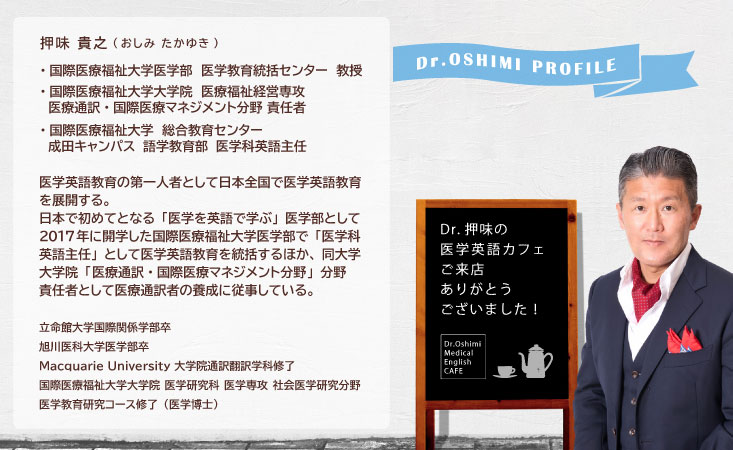
こんにちは。「医学英語カフェ」にようこそ!
ここは「コーヒー1杯分」の時間で、医学英語にまつわる話を気軽に楽しんでいただくコーナーです。
本日のテーマは「英語での症例プレゼンテーション:実践編」です。
海外での臨床実習において必要となる医学英語スキルは「医療面接」「カルテ記載」と「症例報告 = 症例プレゼンテーション」の3つです。
そしてこの3つの中で最も重要度が高く、また難易度も高いのが「症例プレゼンテーション」のスキルです。この「医学英語カフェ」でも「Menu 30 英語での症例プレゼンテーション:基礎編」と「Menu 49 英語での症例プレゼンテーション:中級編」において、この難しいスキルの習得方法についてご紹介させていただきました。しかし実際の医療現場において英語での症例プレゼンテーションを実践できるようになるためには、もう1つレベルアップする必要があります。
そこで今月は、英語圏の医療現場での実践が可能となる「英語での症例プレゼンテーション:実践編」をご紹介いたします。
残念な英語症例プレゼンテーションとは?
英語圏の医療現場で通用する症例プレゼンテーションを考える上で、「英語圏の医療現場では通用しない残念な症例プレゼンテーション」を考えることは有用です。私がこれまで遭遇してきた「残念な英語症例プレゼンテーション」には下記の3つの種類があります。
Random-Walk Presentation
これは英語での症例プレゼンテーションの「型」に沿っておらず、系統立っていないプレゼンテーションです。
日本の医学生の医療面接を観察していると、下記の「語呂合わせ」を使う方が多いと感じています。
O: Onset
P: Provoking & Palliating Factors
Q: Quality
R: Region & Radiation
S: Severity
T: Timing
か:家族歴
き:既往歴
く:薬&アレルギー
け:健康診断
こ:海外渡航歴
さ:酒&タバコ
し:職業・食事
す:睡眠
せ:性活動
そ:その他解釈モデルなど
そしてこれをそのまま症例プレゼンテーションにも応用している学生さんが多いのですが、この語呂合わせは医療面接だけでなく、症例プレゼンテーションにおいても全く通用しないだけでなく、使った場合にはその学生の印象がかなり悪くなりますので注意してください。
こういった安直な語呂合わせは学生目線では試験対策として便利なように見えますが、医療面接や症例報告では「順序も重要!」なのです。上記の語呂合わせの項目で英語での医療面接や症例プレゼンテーションを行った場合、「あなたはどこでそんな(ひどい)教育を受けてきたの?」と(本気で)軽蔑されますので、十分に注意してください。
医療面接も症例プレゼンテーションも決まった項目を決まった順序で述べていく必要があります。「何をどの順序で述べていくべきかわからない」という場合、その症例プレゼンテーションは Random-Walk Presentation となってしまいます。「何をどの順序で述べていくべきかわからない」という方は、「基礎編」を読んで症例プレゼンテーションの「型」を身につけてください。
Cherry-Picking Presentation
これは医学生が都合のよい情報だけを拾って報告し、診断に必要な情報が十分に提供されないプレゼンテーションです。
症例プレゼンテーションの目的は「患者情報の並列化」です。指導医にとっては医学生の教育だけでなく、対象となる患者の診断や治療に必要な情報収集の場でもあります。ですから医学生が自分の判断で「これは述べなくても問題ない」と判断しても、指導医にとっては「その情報を削除されては困る!」となる場合もあるのです。
「現病歴」History of Present Illness に関してもこのようなことは起こりますが、特に「社会歴」Social History や「身体診察」Physical Examination に関しては、指導医から見て「そこは省略してもらいたくないんだけど…」と感じることが多くあります。
また症例プレゼンテーションでは「陰性となる関連項目」pertinent negatives も述べる必要があります。この pertinent negatives を含めて「どの項目をどんな英語表現で述べていくべきかわからない」という方は、「中級編」を読んで症例プレゼンテーションで述べるべき項目とその英語表現を身につけてください。
Parrot-Style Presentation
これは患者の言ったことを parrot「オウム」のように繰り返しているだけの報告で、診断に関する情報の意味づけがないプレゼンテーションです。
この Parrot-Style Presentation は「基礎編」と「中級編」を忠実に守っているだけの方にも多く見られるプレゼンテーションで、Newspaper-Style Presentation とも呼んでいます。
この Parrot-Style Presentation では、医学生は患者の話した内容をそのまま繰り返すだけで「この情報はなぜ重要なのか」という臨床的判断を行っていません。そのため提供される情報に優先順位はなく、聞き手は診断に必要な情報を自分で探しながら聞く必要があるため、大きな認知的負担がかかります。つまりこのような Parrot-Style Presentation は「診断は聞いている指導医の先生が行ってください」と匙を投げたような感じとなり、非常に印象が悪くなってしまうのです。
以上を簡単にまとめると、「英語での症例プレゼンテーションに不慣れな初学者は、まず Random-Walk Presentation に陥りがちです。そこから「型」を学んでも、必要な情報を省いて自分に都合の良い内容だけを報告する Cherry-Picking Presentation になってしまうことがあります。またたとえ「型」に沿ってすべての項目を丁寧に述べたとしても、臨床的判断を加えずに患者の話した内容をそのまま伝えるだけでは、Parrot-Style Presentation になってしまい、聞き手に大きな認知的負荷を与えます。」ということになります。
理想的な Diagnostic Framing Presentation にするための4つのステップ
これらの残念な症例プレゼンテーションに対して、理想的な診断志向型の症例プレゼンテーションのことを Diagnostic Framing Presentation と呼んでいます。そして英語圏の臨床現場で症例プレゼンテーションを実践する際には、この Diagnostic Framing Presentation を行う必要があります。
ではこの Diagnostic Framing Presentation を行うには、どのような点に注意すれば良いのでしょう?ここではその具体的な4つのステップをご紹介します。
1. Patient Information: Use a One-Liner with Semantic Qualifiers
症例プレゼンテーションにおいて最初の項目となる Patient Information ですが、「基礎編」でも示しているように、下記の項目を入れた「インパクトのある1行の文」one-liner で表現するのが一般的です。
Patient Information: Basic One-Liner
- • Age: 年齢
- • Sex: 性別
- • Pertinent risk factors: 鑑別疾患に関連のあるリスクファクター
- • Duration of the chief complaint: 主訴の持続時間
- • Chief complaint: 主訴
しかし Diagnostic Framing Presentation では、最後の Chief Complaint を semantic qualifiers で修飾する必要があります。
Patient Information: One-Liner with Semantic Qualifiers
- • Age: 年齢
- • Sex: 性別
- • Pertinent risk factors: 鑑別疾患に関連のあるリスクファクター
- • Duration of the chief complaint: 主訴の持続時間
- • Chief complaint modified with semantic qualifiers: semantic qualifiers で修飾された主訴
この semantic qualifiers とは、descriptive terms that classify clinical findings to refine differential diagnosis「鑑別診断を絞るために、臨床所見を分類・特徴づける医学用語」のことであり、私は通常「臨床的な意義を与える医学英語」として説明しています。そしてこの One-Liner with Semantic Qualifiers とは、 具体的には下記のようなものとなります。
Case 1: The patient is a 34-year-old man with no significant medical history, who presented with a gradual-onset, bilateral squeezing headache with distracting intensity, persistent for several hours, sometimes relieved with physical activity.
Case 2: The patient is a 29-year-old woman with a history of recurrent headaches, who presented with a six-hour history of gradual-onset unilateral pulsating headache with disabling intensity, associated with nausea, photophobia, and prior episodes with aura.
どちらの症例も headache が主訴ですが、Case 1では tension headache「緊張性頭痛」を示唆する semantic qualifiers が、Case 2 では migraine「片(偏)頭痛」を示唆する semantic qualifiers がそれぞれ使われています。
このようにまずは最初の項目である Patient Information において、どのような鑑別疾患を考えているのかを明確に示唆する必要があります。そのために Chief Complaint を semantic qualifiers で修飾するということを心がけてください。
2. HPI: Focus on Pertinent Positives & Negatives for Differential Diagnosis
症例プレゼンテーションで最重要なのが History of Present Illness「現病歴」です。ここでは下記の項目に沿って述べるように心がけましょう。
History of Present Illness (HPI)
- • Chronological changes of the chief complaint
- • Detailed information about the chief complaint
- • Symptoms associated with the chief complaint
- • Patient’s concerns
また HPI では「陽性となる関連項目」である pertinent positives と「陰性となる関連項目」である pertinent negatives を述べる必要があるのですが、これらの両方、特に 下記に赤字で示しているpertinent negatives を述べない医学生が多いので、注意して述べるようにしてください。
Patient Information with Semantic Qualifiers
A 58-year-old man with poorly controlled hypertension and hyperlipidemia presented with progressively worsening, exertion-induced, substernal chest pressure over the past four days.
History of Present Illness with Pertinent Positives & Negatives for Differential Diagnosis
Four days prior to presentation, the patient began experiencing intermittent chest discomfort described as a dull, pressure-like sensation localized to the retrosternal area. These episodes occurred during moderate physical exertion, such as walking uphill, and consistently subsided within a few minutes of rest. At that time, the discomfort was mild, non-radiating, and lasted less than five minutes per episode.
Two days prior, the patient noticed that the episodes became more frequent and slightly more intense. The pain continued to appear with exertion but required longer periods of rest to resolve. There was still no radiation, and the discomfort remained non-pleuritic and non-positional. He reported no relief from over-the-counter analgesics.
On the day prior to admission, he experienced his most severe episode while carrying groceries up a short flight of stairs. The pain was moderate in intensity, lasted approximately 20 minutes, and was accompanied by a sense of breathlessness. He denied diaphoresis, nausea, vomiting, palpitations, or lightheadedness. There was no recent trauma, cough, fever, or upper respiratory symptoms. The pain resolved spontaneously with rest.
Since that episode, he has been pain-free at rest but has avoided exertion due to fear of recurrence. He expresses growing anxiety about the possibility of a serious heart problem, particularly because his father had a myocardial infarction at a similar age.
3. PMH-ROS & Physical Exam: Present Systematically
History of Present Illness を述べた後は、Past Medical History「既往歴」から Review of Systems「システムレビュー」まで、必要な項目を適切な順序で全て述べるようにしましょう。また Physical Examination「身体診察」においても、取得してきた情報は全て述べてください。こうすることで Cherry-Picking Presentation となることを避けることができます。
4. Summary: Combine One-Liner + Pertinent Positives Modified by Semantic Qualifiers
症例プレゼンテーションにおいて、最も重要な部分が最後の Summary です。診療科や診療場面によってはこの Summary だけを述べることが求められる場合もあるので、症例プレゼンテーションの準備をする際にはこの Summary から作っていくことを意識してください。
そして Diagnostic Framing Presentation において、Summary は下記の項目を含むことが期待されます。
Summary
- • One-liner with semantic qualifiers
- • Pertinent positives modified with semantic qualifiers
つまり最初の項目である Patient Information に加え、現病歴以外の医療面接の項目や身体診察の項目の中から「陽性となる関連項目」である pertinent positives を選び、それらを semantic qualifiers を使って表現すれば良いのです。
Summary
In summary, the patient is a 58-year-old man with poorly controlled hypertension and hyperlipidemia presented with progressively worsening, exertion-induced, substernal chest pressure over the past four days, characterized by increasing frequency and duration of episodes, lack of response to over-the-counter analgesics, and associated exertional breathlessness. He reports recent limitation of activity due to fear of recurrence and has a family history of myocardial infarction in a first-degree relative. On physical examination, he appeared mildly anxious with delayed capillary refill and cold extremities.
このようにまずは Summary を作成し、長い症例プレゼンテーションが敬遠される救急医療の現場などではこの Summary の部分だけを伝えるように心がけてください。他の部分は必要に応じて入れることで、Cherry-Picking Presentation となる心配もなくなります。
最後に、症例プレゼンテーションでは原稿をそのまま読み上げるのではなく、要点をメモにまとめ、それを自分の言葉で伝えるのが一般的であるということを覚えておいてください。
書かれた文章をただ読み上げるだけのプレゼンテーションは、聞き手にとって認知的負荷が高くなり、内容が頭に入りにくくなります。伝わりやすい症例プレゼンテーションとは、話し手自身が内容を理解し、自分の言葉で話しているものです。
皆さんも、原稿を読み上げるのではなく、自分の英語でわかりやすく伝える症例プレゼンテーションを目指してくださいね。
さて、そろそろカップのコーヒーも残りわずかです。最後に今回ご紹介した 4 Steps for Diagnostic Framing Presentation をもう一度まとめておきます。
4 Steps to Deliver an Effective Diagnostic Framing Presentation
Step 1. Patient Information: Use a one-liner with semantic qualifiers
Step 2. HPI: Highlight pertinent positives and negatives to guide the differential diagnosis
Step 3. PMH-ROS, and Physical Exam: Present systematically to avoid Cherry-Picking Presentation
Step 4. Summary: Combine a one-liner with key pertinent positives using semantic qualifiers
では、またのご来店をお待ちしております。
「Dr. 押味の医学英語カフェ」では、読者の皆さまがこの連載で取り上げてほしい医学英語のトピックを募集しています。こちらのリンクよりお送りください。
国際医療福祉大学医学部 医学教育統括センター 教授
押味 貴之










